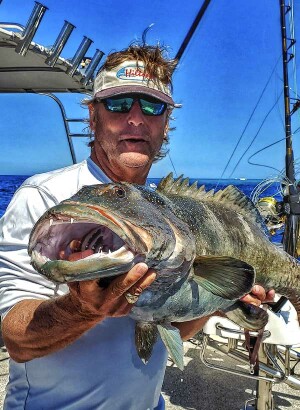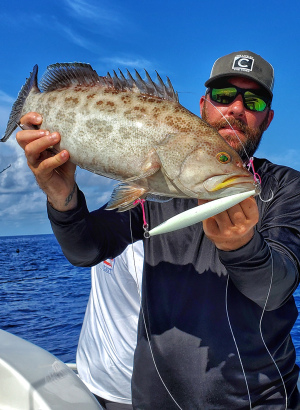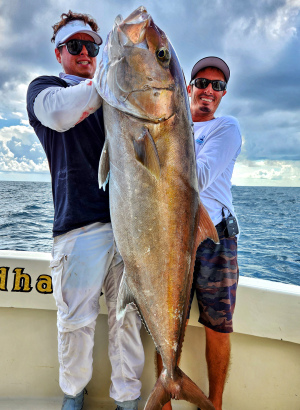Embark on an unforgettable amberjack fishing journey with our expert guide. Discover the thrill of battling these fierce fighters using top techniques, gear, and baits, and learn the best spots in Florida for an adrenaline-pumping adventure. Perfect for both novice and seasoned anglers aiming to conquer the mighty amberjack.

Amberjack - A Guide to Sport Fishing for this Fierce Fighter
Intro to Amberjack Fishing
Summary:
- Introduction to Amberjack: Exploration of the greater amberjack's characteristics, emphasizing its size, power, and the challenge it poses to anglers.
- Techniques for Amberjack Fishing: Effective strategies and fishing tips to successfully hook and land amberjack.
- Choosing the Right Gear: Discussion on the importance of strong tackle, including recommended amberjack lures and rigs.
- Bait and Lures: Insights into the most effective amberjack bait and lure options for enticing these formidable opponents.
- Locations for Amberjack Fishing: Highlighting prime spots, with a focus on amberjack fishing in Florida, known for its abundant amberjack population.
- Deep Sea Fishing Tactics: Tips on deep sea fishing, essential for targeting amberjack in their deep-water habitats.
- Conservation and Ethical Fishing Practices: Emphasizing the importance of sustainable fishing practices to ensure amberjack populations remain healthy for future generations.
Fishing Techniques and Tips
Engaging with amberjack demands not just brute strength but a strategic approach. The choice of tackle is critical; heavy-duty rods, reels, and lines are the order of the day, designed to withstand the amberjack's powerful runs and deep dives. Equally, the selection of amberjack lures and rigs plays a significant role in enticing these predators. From vertical jigging where the jigs mimic wounded baitfish to live baits that appeal to their predatory instincts, the right choice can turn the tide in favor of the angler.
Bait, Lures, and Rigs
The article delves into the art of choosing amberjack bait and lures, offering insights into what works best in various conditions and times of year. Whether opting for live bait such as blue runners or pilchards, or artificial lures that can withstand the depths and the amberjack's scrutiny, knowing what to use and when is a skill honed over time.
Prime Fishing Locations
For those looking to embark on this adventure, the waters off Florida present some of the best opportunities for amberjack fishing. The state's vast coastline offers a plethora of options, from the Gulf of Mexico to the Atlantic, where amberjacks thrive among wrecks and reefs, waiting for the unwary or the skilled.
Amberjack Fishing Essentials
Amberjack fishing demands specialized equipment to handle the immense power and size of these formidable fish. Heavy-duty rods with fast action and substantial lifting power are essential, paired with strong, high-capacity reels capable of withstanding intense pressure. Durable, high-test braided lines and robust monofilament leaders are crucial to prevent breakage during fierce battles. Selecting effective hooks is paramount, with circle hooks preferred for bait fishing to ensure secure hook-sets, while assist hooks and jigs are favored for vertical jigging. The right combination of specialized gear enhances the angler's ability to successfully target and land these challenging sportfish, making the investment in quality equipment a necessity for serious amberjack enthusiasts.
Equipment
Amberjack fishing demands specialized equipment to handle the size and strength of these powerful fish effectively. Here's a closer look at the rods, reels, lines, leaders, and hooks suited for amberjack fishing, as well as the importance of using high-quality gear:
Fishing Rods
- Rod Type: For bait fishing, a heavy-duty boat bottom fishing rod is recommended. These rods are designed to handle the strength of amberjack and are typically longer and sturdier than other types of rods. They are equipped with a strong backbone to handle the weight of the fish and the pressure exerted during the fight.
- Rod Features: These rods often feature a strong, durable construction, a comfortable grip, and a high-quality reel seat to securely hold the reel. They are designed to handle heavy line weights, typically in the range of 80-100lb test, to match the strength of the fish.
- Rod Type: When jigging for amberjack, a specialized jigging rod is recommended. These rods are shorter and lighter than traditional rods, allowing for the rapid movement required in jigging. They are designed to handle the powerful fights that amberjack put forth.
- Rod Features: Jigging rods typically feature a high-quality reel seat, comfortable EVA foam grips for non-slip and comfort during fights, and multiple guides for smooth line flow. They also often have a gimbal on the bottom for rod holders and fighting belts. The rod weight for jigging rods is typically in the range of 20-40lb, providing the necessary strength for this technique.
When selecting fishing rods for bait fishing and jigging for amberjack, it's important to prioritize strength, durability, and the ability to handle the vigorous fights that these powerful fish are known for. The rod types and features mentioned above are tailored to meet these requirements, providing anglers with the necessary equipment to effectively target amberjack using both bait fishing and jigging techniques.
Reels
- Conventional: Shimano Talica II 2 Speed Reels, Shimano TranX Baitcasting Reel, Shimano Speed Master, Shimano Calcutta Conquest
- Spinning: Shimano Ultegra FC, Shimano Saragosa SW A, Daiwa Saltiga Expedition, Shimano Stella SW-C
- Jigging: Shimano Ocea Jigger, Studio Ocean Mark, Daiwa Catalina Bay Jigging
Fishing Line
- Line Type: For bait fishing, 80lb-100lb braided line or 80lb-100lb mono are recommended to match the strength of amberjack.
- Leader Length: A 6ft/80lb test leader is suggested as the bare minimum, with the possibility of using longer leaders, such as 12ft or 18ft, particularly in hot conditions when the fish are more selective.
- Line Type: When jigging for amberjack, spectra line in the range of 80-150lb is recommended to handle the vigorous action required in jigging.
- Rod Compatibility: The line should be paired with a stand-up or heavy jigging type rod that is six feet or less in length to effectively apply the required jigging techniques.
When selecting fishing lines for bait fishing and jigging for amberjack, it's important to prioritize strength and durability to handle the powerful fights that these fish are known for. The recommended line types and leader lengths mentioned above are tailored to meet these requirements, providing anglers with the necessary lines to effectively target amberjack using both bait fishing and jigging techniques.
Leaders
- Leader Type: For bait fishing, a mono leader in the range of 80-100lb test is recommended to match the strength of amberjack.
- Leader Length: A 6ft/80lb test leader is suggested as the bare minimum, with the possibility of using longer leaders, such as 12ft or 18ft, particularly fish are more selective.
- Leader Type: When jigging for amberjack, leader material in the range of 100-250lb test is recommended to handle the vigorous fights and prevent the fish from powering into structure and breaking the line.
- Leader Length: The specific leader length for jigging is not mentioned in the provided sources. However, a shorter leader is often preferred for jigging to maintain better control over the fish during the fight.
Hooks for AJ's
- Circle Hooks: Circle hooks are highly recommended for live bait fishing for amberjack due to their design, which promotes better hook sets in the corner of the fish's mouth, facilitating easier catch and release if desired. Sizes such as 7/0, 8/0 to 9/0 are suitable for the typical size of live baits used for amberjack. Amberjack have strong jaws and can put a lot of pressure on hooks during the fight. For this reason, it's crucial to use high-quality, heavy-duty hooks. Circle hooks are often recommended for their effective hooksets and reduced risk of gut-hooking the fish. Brands like Mustad, Gamakatsu, and Owner make reliable circle hooks suitable for amberjack. The best hooks for amberjack fishing are circle hooks, specifically 7/0 - 9/0 Owner circle hooks, as they have been found to have the best success rate. Using circle hooks and bridling the bait through the eye sockets with wax floss can increase the hookup ratio and help keep the bait from being plucked off the hook. Additionally, a 12/0 - 14/0 Mustad circle hook has been recommended for targeting amberjacks. These hooks are suitable for catching amberjacks when using live bait or jigging. The pickier the fish, the smaller the hook size and the longer the leader.
- Hook Placement: When using live bait like Cigar Minnows, Sardines, or Blue Runners, hooking through the cartilage of the nose or the roof of the mouth is effective. This placement ensures the bait remains lively and presents naturally in the water
- Jig Hooks: For jigging, the hooks are often part of the jig itself, which can vary in size and style depending on the jig type. Butterfly jig-type hooks or traditional West Coast Iron like Salas 6X are commonly used for amberjack.
- Hook Size and Type: The specific size of the hook will depend on the jig being used, but it's important to use strong, sharp hooks capable of withstanding the amberjack's power. The jig's action should imitate a fleeing baitfish, and the hook must be robust enough to secure the fish during its aggressive strikes.
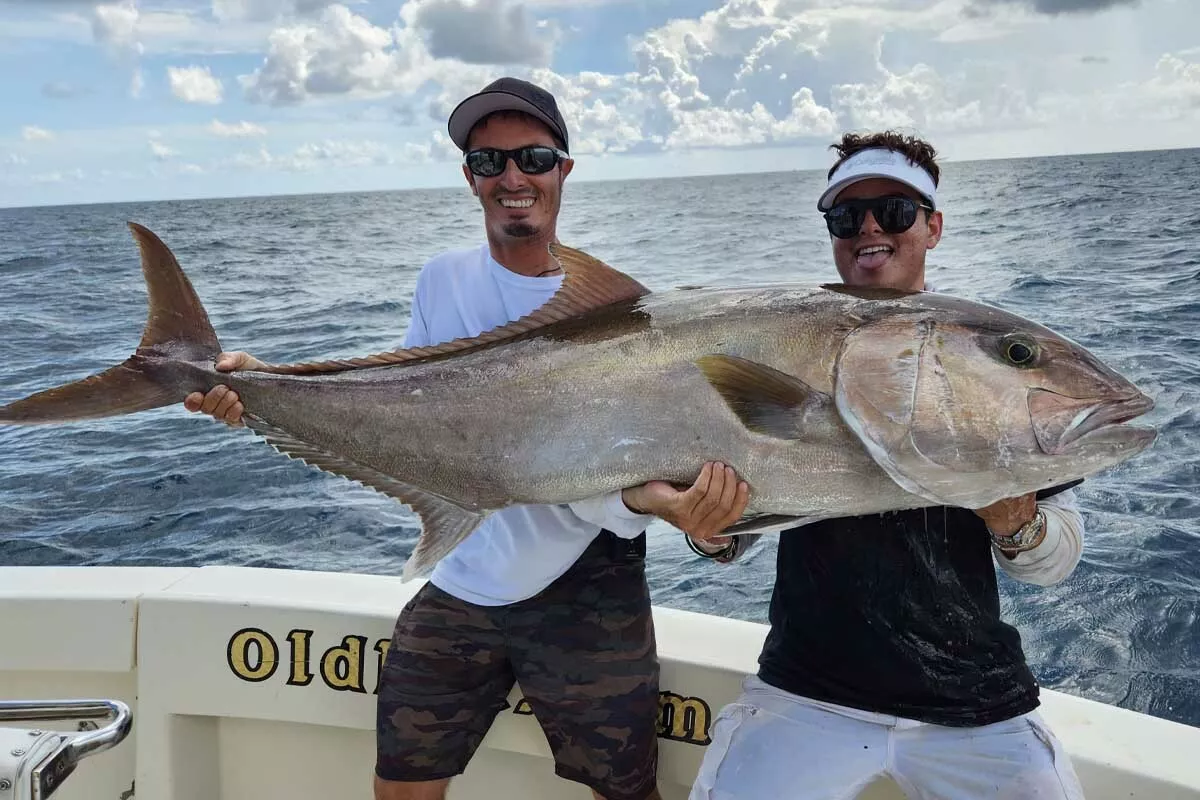
Baits and Lures
- Menhaden: Menhaden, also known as pogies or bunker, are a popular live bait choice for amberjack. They emit a strong scent and have a natural swimming motion that can attract these predatory fish effectively. Menhaden are known to entice larger amberjack due to their size.
- Sardines: Sardines are another excellent live bait option. They are smaller and more agile than menhaden, making them suitable for attracting both smaller and larger amberjack. Their lively swimming action can trigger aggressive strikes.
- Pinfish: Pinfish are a super hardy baitfish used widely in Florida, where anglers most often chum for them in the vast, clean grass beds of the inland waters.
- Blue runners (Hardtails): Small fish in the jack family, known to be effective for amberjack fishing
- Realistic presentation.
- Strong scent and movement.
- Attracts larger amberjack.
- Suitable for a variety of fishing conditions.
- Availability can be limited.
- Live bait can be challenging to keep alive and require a bait tank.
- Smaller fish may steal or damage live bait.
- Jigs: Heavy-duty jigs, such as butterfly jigs or vertical jigs, are a very productive and popular artificial lures for amberjack. These lures imitate wounded or fleeing baitfish, triggering the predatory instincts of amberjack. Jigs come in various shapes and colors to match the local forage. Specific jigs that work well for amberjack include:
- Fonz 600g
- slobseeker 250g to 800g
- Codfather 100g to 800g
- Seafloor Control Rector 210g
- Hot’s Drift Tune Jig 100 to 330g
- Lamble Bait Half Pitch Series II 200 to 280g
- Fishing Labs Deep Liner FB Jig 200 and 250g
- Plugs: Diving plugs that mimic baitfish, like swimbaits or stickbaits, can also attract amberjack, if you are able to chum the AJ's up to the surface. These lures create a realistic swimming action and can be trolled or cast to cover more water. The addition of rattles or noise-making features can enhance their effectiveness.
- No need to keep live bait.
- Versatile and can be used in different fishing scenarios.
- Can trigger reaction strikes.
- May not always replicate the scent and movement of live bait.
- May require more angler skill in terms of presentation and retrieval.
- Smaller amberjack may be less interested in larger lures.
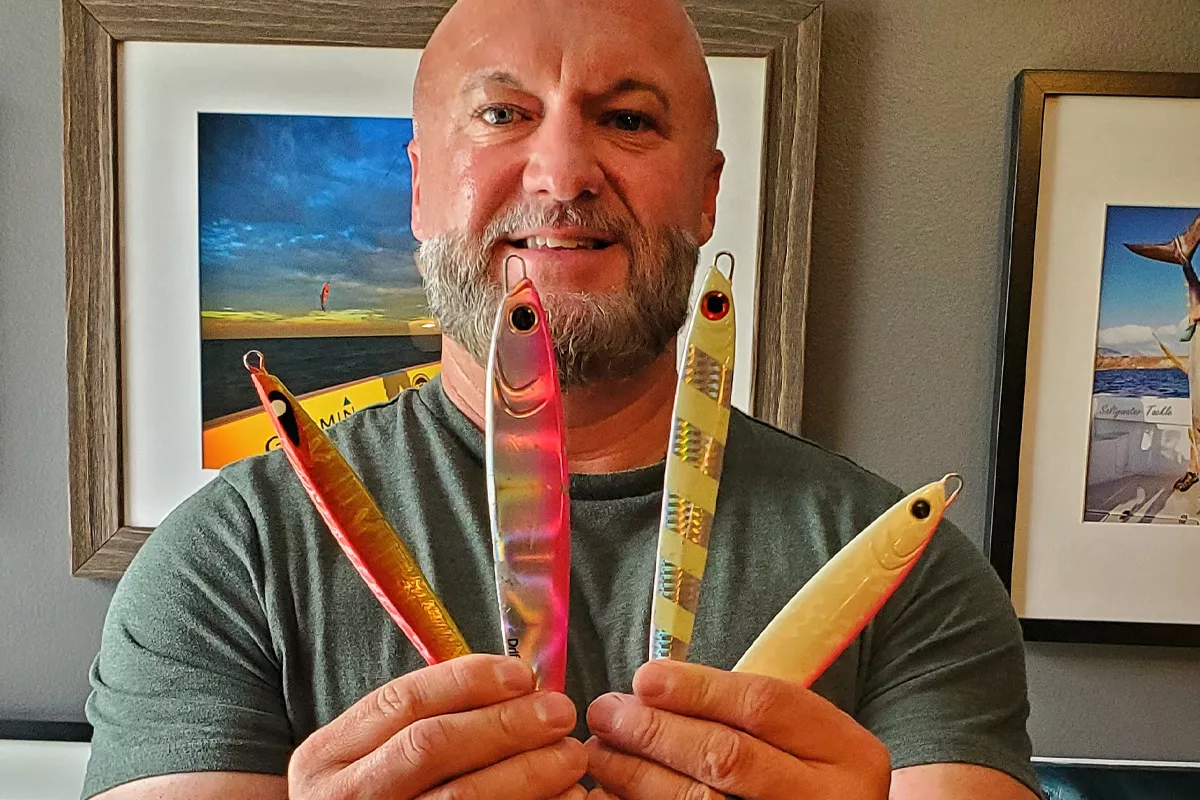
Fishing Techniques
Here's a simple explanation of bottom fishing, trolling, and drifting techniques:
Bottom Fishing
- Explanation: Bottom fishing involves dropping your bait or lure to the seabed, targeting fish that dwell near the bottom, such as amberjack. Once your bait reaches the bottom, you wait for a bite.
- Key Ideas:
- Use heavy sinkers to quickly get your bait down to the bottom.
- Common baits include cut bait, squid, or live bait like menhaden or sardines.
- Fish near structures like reefs, wrecks, or underwater features where fish congregate.
Trolling
- Explanation: Trolling involves trailing your bait or lures behind a moving boat at varying speeds, covering a large area of water to locate active fish. It's often used for species like tuna or mahi-mahi.
- Key Ideas:
- Use downriggers or planer boards to control the depth of your baits or lures.
- Choose lures that mimic the local baitfish or use natural baits like ballyhoo or squid.
- Vary your trolling speed and direction to find where the fish are biting.
Drifting
- Explanation: Drifting involves allowing your bait or lures to drift naturally with the current, often used in open water or over reefs. It's effective for species like snapper or grouper.
- Key Ideas:
- Use a drift sock or sea anchor to control your drift speed and direction.
- Drift over known fish-holding areas, such as drop-offs, underwater structures, or weed lines.
- Keep your bait or lure close to the bottom or at the depth where the fish are holding.
Advanced Techniques
- Jigging: Involves using specialized jigs that are jerked up and down to attract fish like amberjack or kingfish.
- Kite Fishing: Utilizes a kite to suspend baits over the water, often used in windy conditions to present baits to sailfish or tuna.
Locating and Catching AJ's
Amberjack fishing requires understanding their habitat, behavior, seasonal patterns, and effective fishing strategies. Amberjacks are predominantly found in offshore waters, around reefs, wrecks, and artificial structures, where they hunt for smaller fish and crustaceans. They exhibit seasonal migration, moving closer to shore in warmer months and to deeper waters during cooler months. Anglers can increase their success by adjusting fishing techniques to these patterns, using live bait and trolling near structures in warmer months, and focusing on bottom fishing and jigging in cooler months. Utilizing fish finder technology enhances locating amberjack by identifying underwater structures, depth changes, and baitfish schools, while considering environmental factors like tides, currents, and weather conditions. Proper fighting techniques and equipment are crucial when landing amberjacks to prevent equipment failure, minimize injury, and ensure successful catch and release if desired. This involves tiring the fish, carefully reeling it in, and using a gaff or net appropriately, while handling the fish with care to avoid harm to both the angler and the fish.
Habitat and Behavior
- Reefs: Amberjack are commonly found around natural reefs, where they feed on smaller fish, crustaceans, and other prey species that seek refuge in the reef's complex structure.
- Wrecks: Wrecks and sunken vessels provide excellent habitat for amberjack, offering shelter and attracting a diverse array of marine life. These fish are known to congregate around wrecks, feeding on the abundance of prey that seek shelter in and around these structures.
- Artificial Structures: Artificial reefs, oil rigs, and other man-made structures also attract amberjack. These structures often provide vertical relief and create environments similar to natural reefs, making them prime hunting grounds for these predatory fish.
Seasonal Migration Patterns
- Spring and Summer: During warmer months, amberjack are more commonly found in shallower waters and closer to shore, particularly around reefs and wrecks. They may move into shallower waters to feed and spawn.
- Fall and Winter: As water temperatures cool, amberjack tend to migrate to deeper waters and offshore locations. They may follow baitfish migrations or seek out warmer water temperatures to maintain their metabolism during the colder months.
Fishing Strategies
- Spring and Summer: Targeting shallower reefs and wrecks can be productive during warmer months when amberjack are more likely to be inshore. Live bait fishing near structure or trolling around known hotspots can yield good results.
- Fall and Winter: As water temperatures drop, focus on deeper offshore reefs, wrecks, and artificial structures. Bottom fishing with heavy tackle or jigging near the seabed can be effective for targeting deeper-dwelling amberjack.
Finding Amberjack
- Understanding Fish Finder Basics:
- Fish finders use sonar technology to detect underwater objects, including fish, structures, and the seabed.
- Modern fish finders often come with advanced features like GPS mapping, side imaging, and down imaging, providing detailed information about the underwater environment.
- Identifying Potential Fishing Spots:
- Look for structures: Use the fish finder to locate underwater structures such as reefs, wrecks, rock piles, or artificial reefs. These areas often attract amberjack and other predatory fish.
- Pay attention to depth changes: Amberjack are commonly found in deeper waters, so look for depth changes or drop-offs where fish might congregate.
- Search for baitfish: Amberjack are predatory fish and often follow schools of baitfish. Use the fish finder to locate baitfish schools, which can indicate the presence of amberjack nearby.
- Interpreting Fish Finder Readings:
- Fish arches: When amberjack or other fish pass under the boat, they will appear on the fish finder screen as arches or marks. Larger arches may indicate bigger fish like amberjack.
- Structure and bottom composition: Pay attention to the composition of the seabed and any structures that appear on the fish finder screen. Amberjack are often associated with specific types of underwater structures.
- Considering Environmental Factors:
- Tides: Understanding tidal movements is crucial for fishing success. Fish often feed more actively during tidal changes, so plan your fishing trips around incoming or outgoing tides.
- Currents: Strong currents can affect the behavior and location of fish. Use the fish finder to locate areas where currents are converging or where eddies are forming, as these can be productive fishing spots.
- Weather conditions: Weather patterns can impact fish behavior and fishing conditions. Pay attention to wind direction, barometric pressure, and weather forecasts when planning your fishing trips.
Landing the Catch
- Prevents Equipment Failure: Fighting an amberjack puts immense stress on fishing tackle, including rods, reels, lines, and hooks. Using proper techniques helps distribute this stress and reduces the risk of equipment failure such as broken lines, snapped rods, or bent hooks.
- Minimizes Injury: Improper fighting techniques can also lead to injury, both to the angler and the fish. Jerking or yanking on the rod excessively can cause muscle strains or even loss of balance, while mishandling the fish during the landing process can result in injuries to both parties.
- Tiring the Fish: Once hooked, allow the amberjack to tire itself out by applying steady pressure and using the rod's bend to absorb its powerful runs and dives. Avoid overly aggressive movements that could lead to the fish breaking off or causing injury.
- Bringing the Fish to the Boat: Once the amberjack is sufficiently tired, carefully reel it closer to the boat while maintaining steady pressure on the line. Be prepared for sudden bursts of energy from the fish, especially as it nears the surface.
- Using a Gaff or Net: Depending on personal preference and the size of the fish, anglers can use either a gaff or a net to land the amberjack.
- Handling the Fish: Once landed, handle the amberjack with care to avoid injuring yourself or the fish. Use wet hands or gloves to grip the fish securely and support its body weight. If practicing catch-and-release, minimize handling time and release the fish gently back into the water.
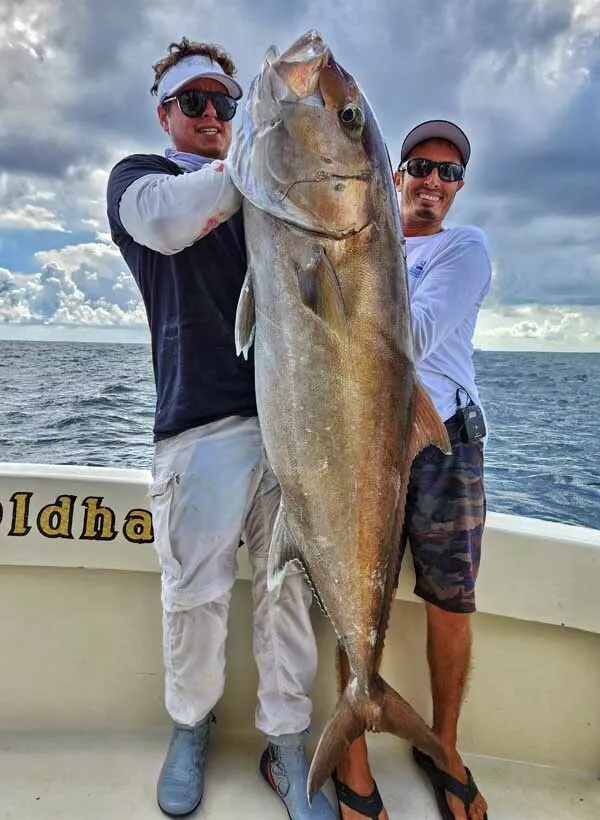
Additional Tips and Tricks
- Size Limits: Many regions impose size limits on harvested amberjack to protect juvenile fish and maintain healthy populations. Anglers are often required to measure the total length of the fish from the tip of the snout to the end of the tail, with undersized fish typically required to be released.
- Bag Limits: Bag limits specify the maximum number of amberjack that anglers are allowed to harvest per day or per trip. These limits help prevent overfishing and ensure sustainable fishing practices. It's important for anglers to be aware of and adhere to these limits to avoid fines or penalties.
- Seasonal Closures: Some areas may implement seasonal closures for amberjack fishing to coincide with their spawning seasons or to protect the species during vulnerable periods. Anglers should check local regulations and fishing advisories to ensure compliance with any seasonal closures.
- Gear Restrictions: Certain gear restrictions may apply to amberjack fishing, such as limits on the types of hooks, lures, or bait allowed, as well as restrictions on fishing methods like spearfishing or snagging.
- Protected Areas: Certain marine protected areas or marine reserves may prohibit or restrict fishing for amberjack to conserve biodiversity and protect sensitive habitats. Anglers should familiarize themselves with designated protected areas and respect any fishing restrictions in place.
- Fishing Licenses and Permits: Anglers must obtain the appropriate fishing licenses and permits before engaging in amberjack fishing. These licenses help support conservation efforts and fund resource management programs. Additionally, some regions may require additional permits for fishing in specific areas or for targeting certain species.
Cooking and Eating
Amberjack Recipes:
- 4 amberjack fillets (about 6-8 ounces each)
- 2 tablespoons olive oil
- 2 cloves garlic, minced
- 1 lemon, thinly sliced
- 2 tablespoons fresh herbs (such as parsley, thyme, or rosemary), chopped
- Salt and pepper to taste
- Lemon wedges for serving
- Preheat your grill to medium-high heat.
- In a small bowl, mix together the olive oil, minced garlic, and chopped herbs.
- Season the amberjack fillets with salt and pepper on both sides.
- Place the lemon slices on the grill and cook for 1-2 minutes per side until lightly charred. Remove from the grill and set aside.
- Brush the herb and garlic mixture over both sides of the amberjack fillets.
- Place the fillets on the grill and cook for 3-4 minutes per side, or until the fish is cooked through and easily flakes with a fork.
- Transfer the grilled amberjack to a serving platter and garnish with the grilled lemon slices.
- Serve immediately with lemon wedges on the side.
- Baking: Baking amberjack fillets with herbs, spices, and a squeeze of lemon juice creates a flavorful and healthy dish.
- Pan-Searing: Searing amberjack fillets in a hot skillet with a bit of olive oil produces a crispy exterior while keeping the fish moist and tender on the inside.
- Broiling: Broiling amberjack fillets under high heat quickly cooks the fish while giving it a slightly charred and caramelized exterior.
- Ceviche: Marinating diced amberjack in citrus juices, onions, peppers, and herbs creates a refreshing and tangy ceviche dish that highlights the fish's delicate flavor.
- Mercury Levels: Like many predatory fish, larger amberjack can accumulate higher levels of mercury in their tissues. Mercury is a toxic metal that can be harmful to humans, particularly pregnant women, nursing mothers, and young children. To minimize exposure to mercury, it's advisable to limit consumption of larger, older fish and opt for smaller-sized amberjack.
- Histamine Poisoning: Amberjack is susceptible to histamine buildup, especially if not handled and stored properly after being caught. Histamine poisoning, also known as scombroid poisoning, can occur if fish are not chilled promptly after capture or if they're stored at improper temperatures. Symptoms of histamine poisoning include nausea, vomiting, diarrhea, and headaches. To reduce the risk of histamine poisoning, ensure that amberjack is properly handled, chilled, and stored at temperatures below 40°F (4°C).
- Ciguatera Poisoning: In some tropical and subtropical regions, including parts of the Caribbean, Gulf of Mexico, and Pacific Islands, amberjack and other reef fish can be at risk of carrying ciguatoxins. Ciguatera poisoning can occur when humans consume fish that have ingested toxic dinoflagellates, resulting in symptoms such as gastrointestinal issues, neurological symptoms, and even cardiovascular effects. To minimize the risk of ciguatera poisoning, it's advisable to check local advisories and regulations regarding fish consumption, especially in areas where ciguatera is prevalent.
- Parasites: Like many fish, amberjack can harbor parasites such as roundworms and tapeworms. Cooking fish thoroughly to an internal temperature of at least 145°F (63°C) can help kill any parasites present. Additionally, visually inspecting the fish for signs of parasites and carefully removing any affected areas before cooking can further reduce the risk of parasite transmission.
Conclusion
- Amberjack are prized game fish known for their powerful fighting spirit, making them a thrilling catch for anglers of all skill levels.
- Understanding amberjack behavior, preferred habitats, and seasonal patterns can greatly enhance your chances of success on the water.
- Utilizing the right equipment, including heavy-duty rods, strong reels, and appropriate bait or lures, is crucial for effectively targeting and landing these formidable fish.
- When fishing for amberjack, it's important to adhere to local regulations and guidelines to ensure sustainable fishing practices and protect fish populations for future generations.
- Amberjack fishing offers an opportunity to connect with nature, challenge yourself, and create lasting memories on the water. Whether you're a seasoned angler or a newcomer to the sport, I encourage you to try your hand at catching this prized fish. With proper preparation, patience, and perseverance, you can embark on an exciting adventure and potentially reel in the catch of a lifetime.

